|
|
Post by TheWallsScreamedPoetry on May 7, 2011 11:31:22 GMT
The Doors Equipment
Musician Magazine
August 1981John Densmore: "Billy Cobham and Art Blakey were big influences. I started with Gretsch drums and then switched to Ludwig. 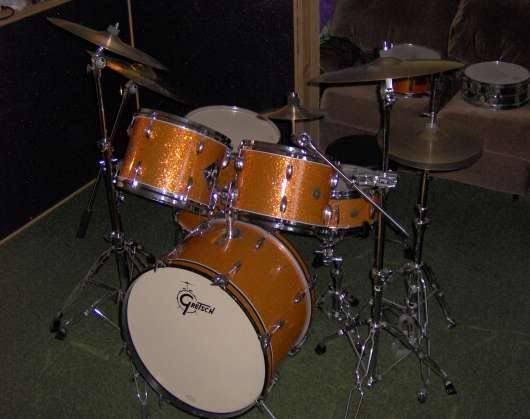 A Gretsch kit from the late 60s. Not Densmore's It was a pretty standard set-up. One tom-tom on the bass drum and a floor tom. Real spectacular! I never went for the two bass drum routine; there are lots of people who can do more with one than most guys can do with two. I liked to take the bottom heads off my toms to make them bark and growl. I hated new skins - I loved the sound of 'em after they'd been beaten to death for months, Snarling as hell - that was my sound." 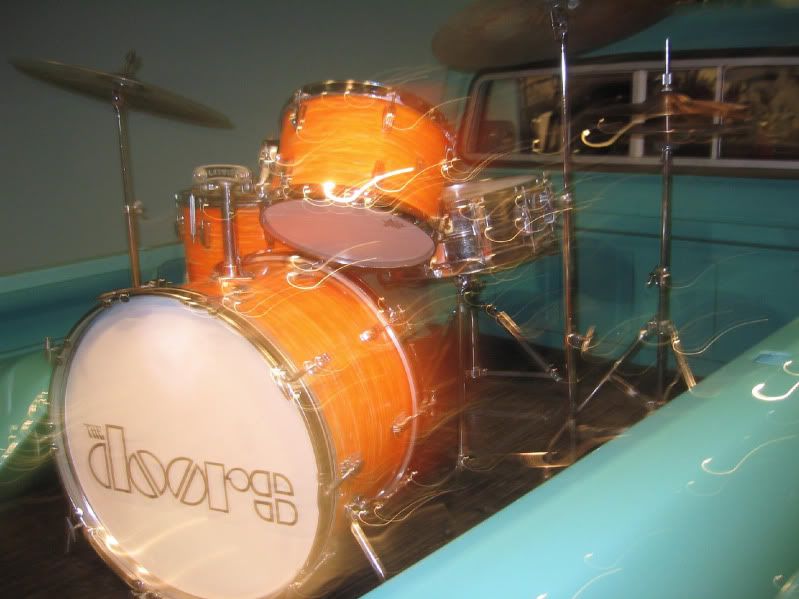 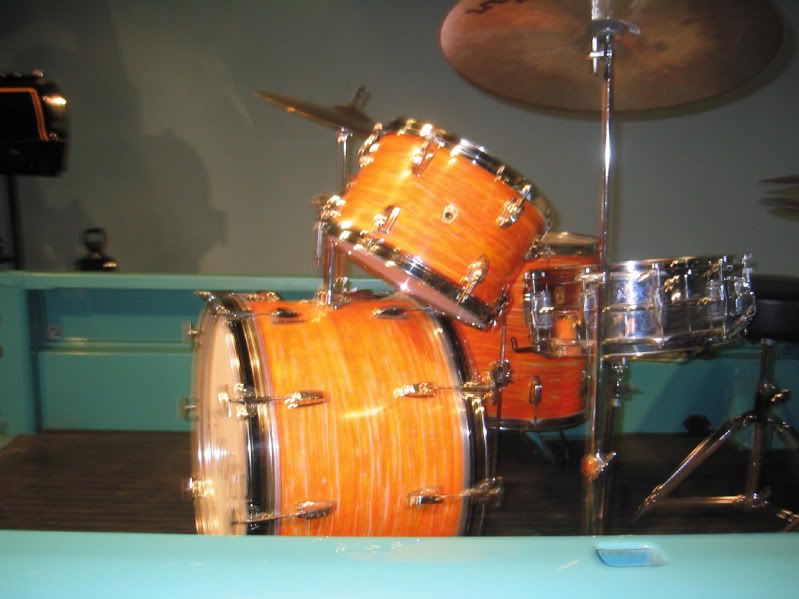 JD's famous Ludwig Mod Orange kit used in such performances as the PBS Special in 1969  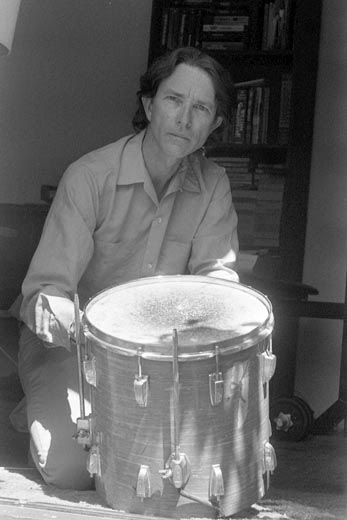 Vince Treanor with John's floor tom which he seems to have inherited.  John with his Ludwig kit. 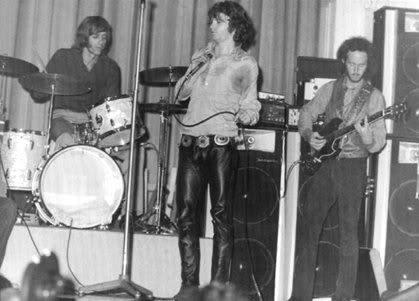 Ray with John's White Ludwig kit in Frankfurt 1968 John Densmore played the rare Mod Orange Ludwig drum sets from 1967 to 1971. This was his signature set on most of The Doors videos and photo shoots. He also played a White Marine Pearl Ludwig set alternating between the two. He is seen playing a White Marine Pearl Gretsch set in some photo and video shots. This was his first set with The Doors.  A 60s White Marine Pearl Ludwig which was similar to JD's alternate set which was seen during the 1968 European Tour. 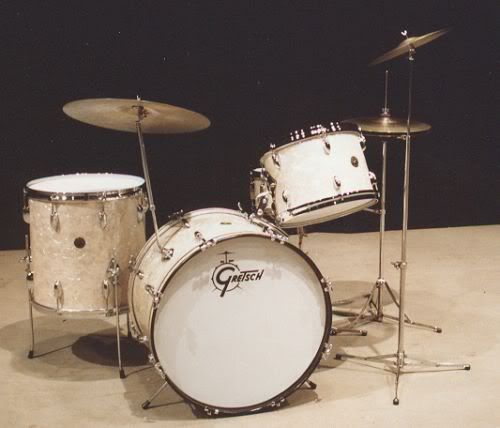 A typical 60s White Marine Pearl Gretsch similar to the one JD used on the debut album.
|
|
|
|
Post by TheWallsScreamedPoetry on May 7, 2011 11:51:28 GMT
In 2008 Ludwig produced replica's of vintage drum configurations from the mid-late 60s This included John's famous Mod Orange kit, the Downbeat.  Downbeat configuration (John's kit: 8x12, 14x14, 14x20) in Citrus Mod Downbeat configuration (John's kit: 8x12, 14x14, 14x20) in Citrus Mod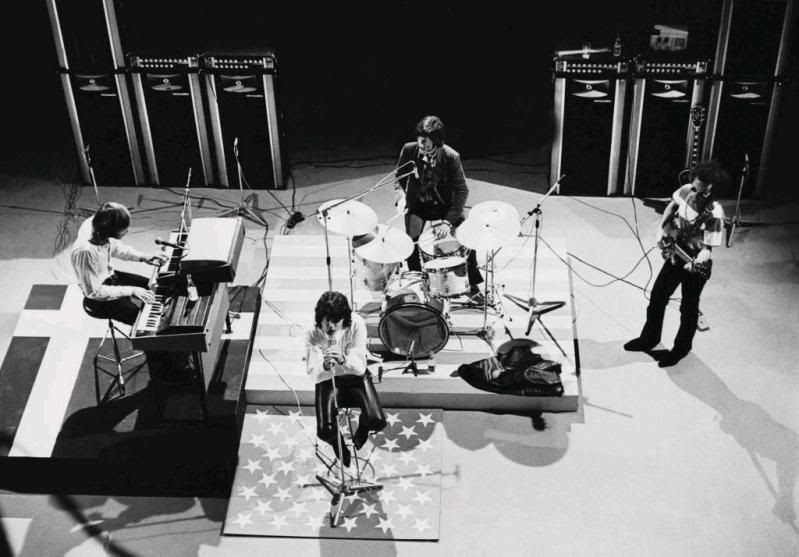 Ariel shot of JD's drums in Denmark 1968. 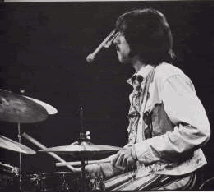 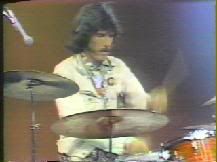 PBS 1969 PBS 1969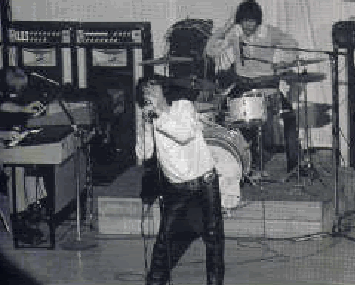 London 1968 London 1968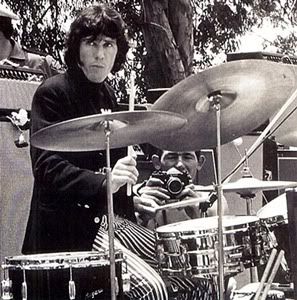 1967 possibly his first Gretsch drum set.  John from behind at the Fillmore East 1968 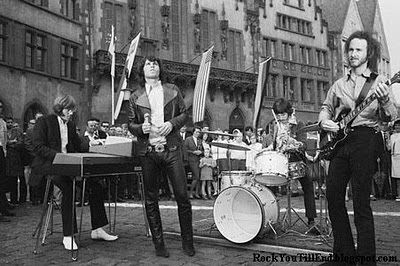 Rohmer Square Frankfurt 1968 John Densmore Drummerworld Interview.Reflecting on his musical contribution to the band, Densmore seizes on an attribute he's long admired in his favorite jazz players. "I found myself wanting to really comment on what was going on musically, especially with Jim--and Ray and Robby, on their solos," he points out. "Just to push them or lay back or whatever was happening in the moment, to encourage that moment. "My main thing is dynamics," he elaborates. "I think this comes from the school orchestra, fortissimo [very loud] and pianissimo [very soft] and everything in between. That's music. You can drum that way. Like in 'The End,' it'll be real soft, and then bam-bam! I drop these cannonballs on the tom-toms--in a real quiet section! What the fuck am I doing? I didn't even know. But later I listened and thought, oh, that heightened the tension, didn't it? Bridges and verses--contrast them, loud and soft." Densmore continued his collaboration with his bandmates after Morrison's untimely demise. In the early 1970s, he pursued a new passion--reggae--with Krieger in The Butts Band before the genre had had much impact in the U.S. "We were in Jamaica, before reggae came here," Densmore says. "The rightful geniuses of reggae--Marley, Jimmy Cliff and a few others--were coming to the States just after us, and they made a big impact and they should have. But we were on it before Clapton did "I Shot the Sheriff" or the Police or any of that. I remember saying to Kenny Edwards, Linda Ronstadt's bass player, 'Hey man, reggae--reggae's comin'. ' He said, 'Reggie?'" |
|
|
|
Post by TheWallsScreamedPoetry on May 7, 2011 15:44:58 GMT
John Densmore's cymbals with the Doors John used Gretsch drums and Zildjian cymbals on the early Doors records, then switched to Paiste formula 602's cymbals with his Ludwig kit. 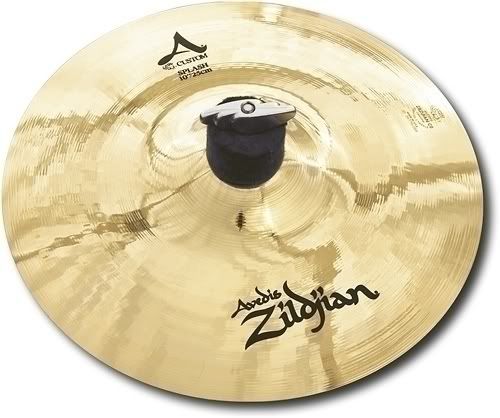 Zildjian 10-inch splash cymbal Ludwig was the US supplier for Paiste cymbals and John after 1967 came used Ludwig drums. When asked about it by a drummer on his forum he replied "after Strange Days they were all 602's my friend , you are correct"  Paiste 602 sound edge Hi-Hat  Paiste 602 thin crash cymbal 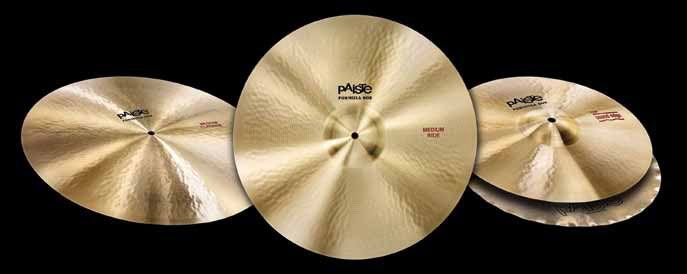 Paiste 602 set JOHN DENSMORE DRUMMER ON THE STORM
by Teri SacconeQ) SPEAKING OF TECHNIQUE, YOUR PLAYING HAD MORE EMPHASIS ON YOUR HANDS RATHER THAN YOUR FEET. A) Like Mitch Mitchell, I have very fast hands. Due to the old school jazz and Be-bop playing, my hands are real fast. My feet are not as fast as they could be. When fusion came along I just about died: those guys are so fast with their feet. I stil have some work to do. But I love some of that bass drum stuff: funk, fusion oh, man! I m always trying to get my foot to go faster. Q) WHAT ABOUT YOUR DRUMKIT BACK THEN? A) Gretch was my original drumkit, then I played Ludwig for many years. Now I have a Pearl kit and a Ludwig snare. Q) DID YOU PLAY DIFFERENTLY LIVE TO COMPENSATE FOR LACK OF A BASS PLAYER? A) Having just Ray s left hand as opposed to a bass player was pretty interesting for a drummer: it wasn t a separate mind holding the beat down which is very helpful. So I had to work real hard at keeping the tempo the same. When Ray would play a solo with his right hand, sometimes he d speed up because his left hand was the bass and he d get into it. But on the other hand, if there had been a bass player he would have been playing more lines, playing more fills which is natural for a musician to do. So there was a little more room in our sound which I filled with little percussive comments and accents on Jim s singing. That was the effect that had on me. Q) DID YOU TUNE YOUR OWN DRUMS BACK THEN? A) Yes. I tuned them loosely to the one, four, and five chords. I had been playing drums since I was in junior high -- marching band, etc. -- and it gave me a good background. I kind of developed what some people say is a unique sound: I love the heads to get real old and loose and rancid and get them to talk back. If you listen to "Hello I Love You," for example, you can hear that the head is really old and it gives it a personality. Then when the head would break and I d have to get a new one I couldn t stand the sound for several weeks cause it sounded too slick. Q) AMERICAN DRUMMERS OFTEN MENTION SCHOOL MARCHING BANDS AS OFFERING GOOD TRAINING. A) The stereotype of marching band would be stiff, military-type music, which is correct. But playing with 40 other musicians gave me a sense of the ensemble side of music. So when it came time to mix our songs in the studio, I had something to say about every aspect of the music. I had played in all kinds of orchestras, dance bands, everything. That helped me a lot and gave me a perspective on the levels, the echo, EQ s, the sounds of every instruments.
|
|
|
|
Post by TheWallsScreamedPoetry on May 8, 2011 9:47:59 GMT
From 14 Reason's To Love John Densmore
Modern Drummer 2010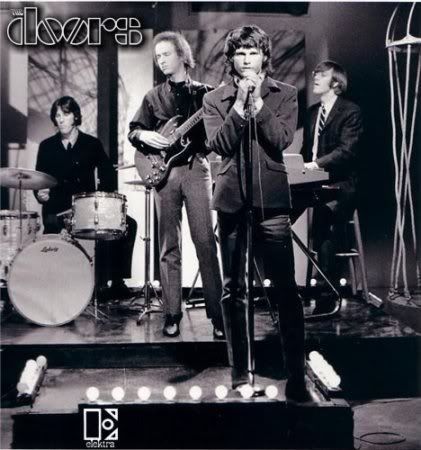 Early photo of John's Ludwig kit That Latin-ish Thing.call it what you like you know what we mean.....the stuttering bell pattern with left hand snare and tom notes, which Densmore works to great effect across The Doors catalogue. From '20th century Fox' of the debut to 'Ship Of Fools' from Morrison Hotel to the title track of LAW. The drummer loved the groove enough to keep playing it with various nuances and The Doors wouldn't be The Doors without it.  Performance Art. Performance Art.The Doors could do a song like the 138 second sugerpuff I Looked At You but on stage and sometimes in the studio they would stretch. Densmore and the other players watched Morrison intently, kept their ears open and flanked Jim whenever he wandered. During a wild 33 minute span on the 1970 Doors Live In New York set the band plays 'Celebration Of The Lizard' and 'When The Music's Over' with a short blues ditty in between, 'Build Me A Woman'. Densmore with his mates navigates the sequence like an avant garde pro, crashing and catching and rolling to highlight the unpredictable Morrison snowballing incantations. 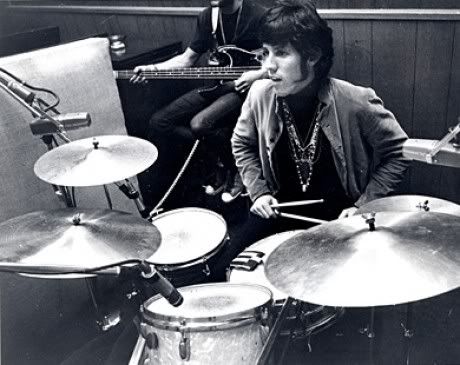 His Ride Cymbal. His Ride Cymbal.Densmore is one of the most recognisable rides in Classic Rock. Sometimes like on 'I see your hair is burning' section of 'LA Woman', the bell sounds so gloriously brittle that you think the cymbal might just shatter. On 'Riders On The Storm' John's ride itself is like falling rain, creating a sustained cinematic atmosphere that lifts the song to the point where it renders the backing track rainstorm almost unnecessary.  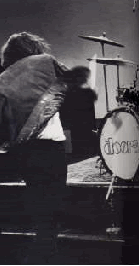 He Remembers His 60s Ideals. He Remembers His 60s Ideals.Long after Morrison's death despite protestations from the other surviving Doors, Densmore has repeatedly exercised his veto power in order to prevent the bands music from being used in TV commercials. These days supplying music for ads may be one of the only ways for a young band to get ahead. But for Classic fat cats who got huge the old fashioned way, through radio, popularity and record sales it can be seen as either greedy or desperate...or both. And Densmore's reasons are noble. 'On stage when we played those songs, they felt mysterious or magic' He told the Los Angeles Times. 'That's not for rent'. 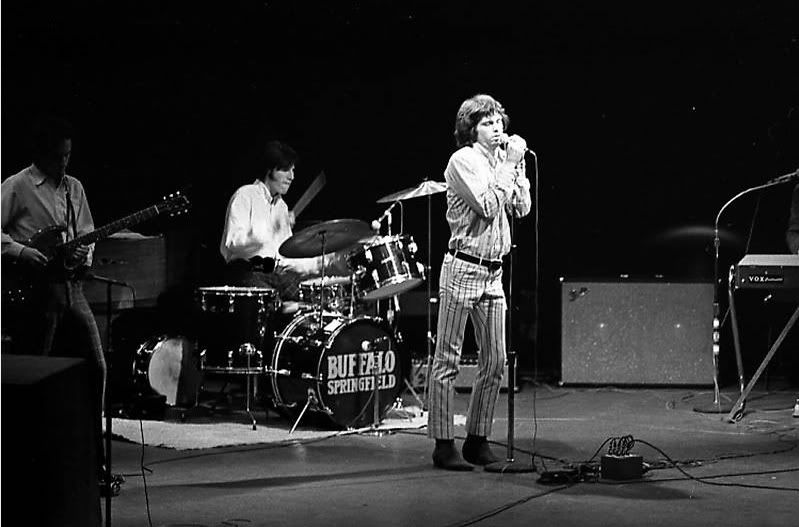 John with borrowed set early 1967. 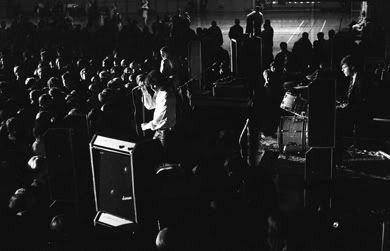 Atmospheric shot of JD drumming from Michigan University 1967.
|
|
|
|
Post by TheWallsScreamedPoetry on May 8, 2011 10:20:08 GMT
'On stage when we played those songs, they felt mysterious or magic' He told the Los Angeles Times.
'That's not for rent'.
More said in that one short sentence than in 40 years of Manzarek ramblings.
At last one of The Doors gets what people like me and Sara have been banging on about all these years.
Respect to JD for that.
|
|
|
|
Post by TheWallsScreamedPoetry on May 10, 2011 8:13:40 GMT
Q - What was your contribution to the Doors songs? A - My main thing beyond the drumming was arranging. So, I didn't know which chord to tell them to play, but my ear told me we needed a change. We needed a solo in some section or a bridge or we needed to modulate, which is going up in key. I think through all my playing in the high school band and orchestra and playing weddings and bar mitzvahs from 7th grade on, my ear was pretty good. So, I had and still have this intuition of where a song should go and when it's boring and what it needs. I couldn't explain it in musical terms, but I could get it across enough so they could do it. So that was my main thing beyond drumming. Gary James' 1987 Interview With John DensmoreI knew intuitively when we needed a bridge or a solo or whatever. Another thing - what I consider my specialty - is the first job of a drummer is to keep the beat. Don't let the band rush or drag. Got to keep a good even feel. Then I found myself adding or punctuating Jim's lyrics with percussive comments. Like in "When The Music's Over" - 'What have they done to my earth - bam bam bam bam. Ripped her and bit her and stuck her with knives - bam bam bam bam.' Or "The End" there's big silences and then I just drop a bomb in there. It just came blasting out of me, I don't know where that came from. John Interview Rhythm & News Magazine 1995Reflecting on his musical contribution to the band, Densmore seizes on an attribute he's long admired in his favorite jazz players. "I found myself wanting to really comment on what was going on musically, especially with Jim--and Ray and Robby, on their solos," he points out. "Just to push them or lay back or whatever was happening in the moment, to encourage that moment. "My main thing is dynamics," he elaborates. "I think this comes from the school orchestra, fortissimo [very loud] and pianissimo [very soft] and everything in between. That's music. You can drum that way. Like in 'The End,' it'll be real soft, and then bam-bam! I drop these cannonballs on the tom-toms--in a real quiet section! What the fuck am I doing? I didn't even know. But later I listened and thought, oh, that heightened the tension, didn't it? Bridges and verses--contrast them, loud and soft." Drummer World Interview.Total Drumsets: The 100 Best Rock Drummers Ever!#96. John Densmore Born - 12/1944 | Nationality - American | Group - The Doors John's playing with The Doors alone would be enough for him to earn his place in our best rock drummers list. His strengths are his real drumer feel and creativity. Not every note is perfectly in time, but that's what makes it sound so good. JOHN DENSMORE AND MICHAEL C FORD AT HEN HOUSE STUDIOSA very good way to examine John Densmore's drum technique. John and Michael C Ford with Drummin' live at the Henhouse. # Michael C Ford was asked by The Doors to join as their bass player. He turned them down and pursued poetry. |
|
wplj
moderator 
Posts: 186
|
Post by wplj on Jul 12, 2011 16:11:31 GMT
'On stage when we played those songs, they felt mysterious or magic' He told the Los Angeles Times.
'That's not for rent'. More said in that one short sentence than in 40 years of Manzarek ramblings. At last one of The Doors gets what people like me and Sara have been banging on about all these years. Respect to JD for that. Word. (Can't believe I just found this thread! Being a drummer, this is awesome ... never knew he used Paiste. Thought he was strictly a Zildjian guy). |
|
wplj
moderator 
Posts: 186
|
Post by wplj on Jul 12, 2011 17:07:36 GMT
That Michael C Ford/Densmore video at the Henhouse is killin', BTW! Thanks for sharing that!
|
|
wplj
moderator 
Posts: 186
|
Post by wplj on Jul 13, 2011 7:02:12 GMT
Does anybody here know anything about the kit with three rack toms that John used during 1970 shows? There are a few not-so-good photos out there ... What make was that kit? Was it a factory model or modified? Any information would be helpful. Thanks!
|
|
|
|
Post by TheWallsScreamedPoetry on Jul 13, 2011 10:14:06 GMT
This whole section of the forum is devoted to the lyrics and music. I did a thread for both Ray and Robby's instruments as well.
Some good info about this kind of theng out there.
Also some interesting stuff about the lyrics as well.
It's an interesting aspect of the band as regards the lyrics nobody can really be wrong.
|
|
|
|
Post by TheWallsScreamedPoetry on Nov 12, 2011 10:02:12 GMT
"John was a jazzer. What was great about him was he was into Miles Davis and John Coltrane and we really hit it off that way. As jazz guys."
Ray Manzarek.
|
|
|
|
Post by TheWallsScreamedPoetry on Nov 18, 2011 17:06:52 GMT
|
|
wplj
moderator 
Posts: 186
|
Post by wplj on Nov 21, 2011 15:52:35 GMT
Yep. Accurate transcription, that.  Can you post a scan of Riders? I wanna see if the guy who transcribed it heard what I hear on that ... Ha!  |
|
|
|
Post by TheWallsScreamedPoetry on Nov 21, 2011 17:18:15 GMT
Riders On The StormI am scanning a few from the Doors complete 1972 songbook for piano and guitar but don't have any drum songbooks I am afraid. I would have thought you would have that mate  All this one here is I swiped from Amazon.
|
|
wplj
moderator 
Posts: 186
|
Post by wplj on Nov 21, 2011 19:35:48 GMT
I can read music, but, as a rule, I don't "learn" most tunes by reading the music ... all by ear, mate.  Only would read music if I was in a situation that required it (i.e.: my old job, drumming in the showband on cruise ships). |
|
|
|
Post by TheWallsScreamedPoetry on Dec 6, 2011 17:08:54 GMT
|
|
|
|
Post by TheWallsScreamedPoetry on Sept 11, 2023 10:42:58 GMT
From Follow The Music #14
VINCE TREANOR:
John soaking wet with shot in his pockets probably weighed a hundred pounds at that time. But he'd make more music out of those simple bass and floor toms and two small toms and a snare drum with three cymbals than these guys with thirty-seven toms and fifty-one cymbals.
BILL SIDDONS:
John wanted to be proud of his work.
He didn't just step out and say, "OK, where do I play?"
He was trying to read Jim, who was barely functioning in the same sphere.
John was the guy who bore most of the weight emotionally.
He was so overwhelmed with what was going on with the group, he left the band at least three times.
John was the jazz player in the band.
I thought he kept perfect time for Jim.
When Jim slowed things down and changed tempo, John was right there with him. It gave the band more elasticity and fluidity than any other band—they would stretch and relax, stretch and relax, in ways that nobody else did, and that gave a dynamic tension to the music.  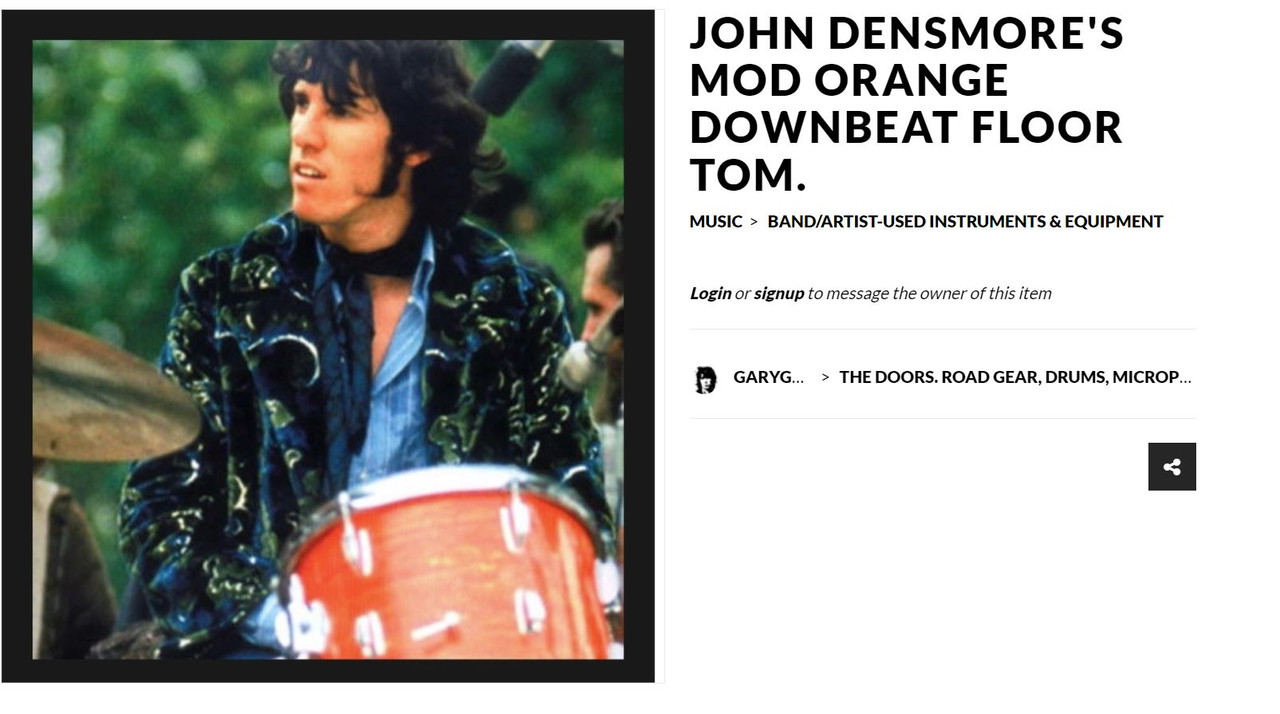
|
|